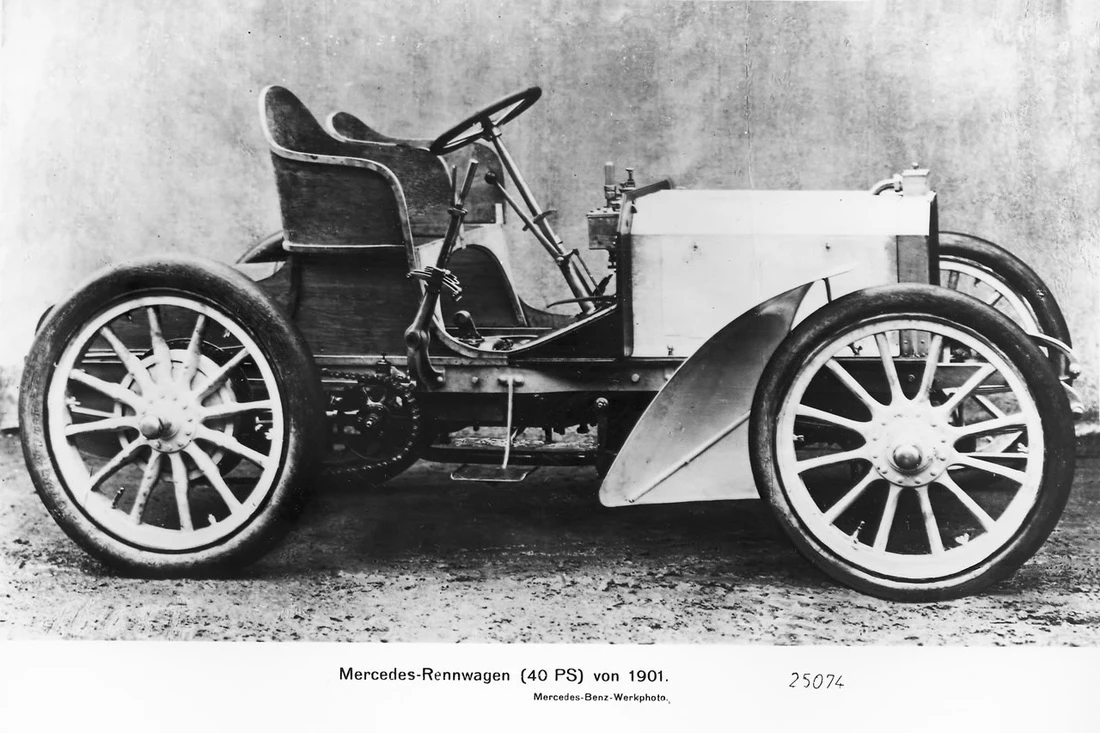Mercedes-Benz cars are so common these days that it's easy to forget, when you pass one in traffic, that you're looking at a direct descendent of the world's first gasoline-powered car, and an automobile lineage that goes back more than 120 years. The Benz part of the name, of course, comes from Karl Benz, who created the original Benz Patent Motorwagen in 1886, a three-wheeled carriage driven at speeds up to 10 mph by a 984 cc four-stroke single cylinder engine that made two thirds of a horsepower.
Sixty miles up the road, Gottlieb Daimler and Wilhelm Maybach, who had already built the world's first internal combustion motorcycle, separately stamped their names into automotive history later that same year by converting a stagecoach to run on a 1.1-horsepower single. These surnames are familiar to any automotive fan – but where did the Mercedes part come from?
From a customer and dealer called Emil Jellinek, as it turns out – or rather, from his daughter's nickname. Emil Jellinek was a wealthy diplomat, tobacco trader and insurance inspector from Austria. He was enough of a fan of what Daimler and Maybach were building in the late 1890s that he began selling cars for them – but also a harsh critic who constantly made suggestions back to the factory.
Above all else, he was a fan of his daughter Adriana, who he had taken to calling Mercedes as a pet name. Jellinek called his house Villa Mercedes. He called his cars Mercedes. At one point he began calling himself Monsieur Mercedes as a racing pseudonym, and in 1903, he legally changed his surname to Jellinek-Mercedes, commenting that it was "probably the first time a father has taken his daughter's name."

It was Jellinek who commissioned the mighty Mercedes 35 hp, convincing Daimler Motoren Gesellschaft (DMG) to build a long, low, wide, stable and demonically fast race car in 1900. No longer inspired by stagecoach or carriage designs, the 35 hp had its engine mounted low in a strong steel chassis that made for vastly superior cornering. In 1901, at the Nice-La Turbie racing event, the 35 hp annihilated the rest of the field with average speeds of 31.9 mph (51.4 km/h) , where the previous year's winner had managed just 19.4 mph (31.3 km/h). This machine was seen as a major leap forward in automobile technology, the first modern car, and it went into production for road use in 1901.
And this is the machine Mercedes-Benz honors today with the release of its Vision Mercedes Simplex concept, a futurist re-imagining of the 35 hp that hints at some design principles the brand is moving toward in the 21st century. Presented at Design Essentials in Nice, France, Vision Mercedes Simplex adheres to the original two-seat, large-wheeled layout of the 35 hp. It's a nostalgic look back with a couple of things to say about the Mercs of the future.

Like the digital radiator grille. Radiators will be a relic of the combustion age, and here the grille is replaced with a black panel/3D display that plays animations, framed in rose gold. It's not as jaw-dropping as the layered LED grille on the Vision EQS concept we saw at Frankfurt last week, but it's still a nice touch.

Then there's the "hyper analog" digital dash, which is designed to present only the information necessary at the precise moment you look at it. Digital lighting behind a translucent white surface presents speedo, dash and navigation functions as you drive, with the most pivotal content centered inside a rose gold ring in the center.

Like the 35 hp nearly 120 years ago, the Vision Mercedes Simplex has a trunk – and it's a removable piece of luggage that reminds us where the term "trunk" actually came from. And while its wheels are not wooden like its ancestor's, they're still wide and exposed, with electric drive systems and logo-stamped tires.
If we're being honest here, the Vision Mercedes Simplex design is a bit of garnish without much meat to it. But it's neat to look at, and a great chance to cast our minds back over a game-changing car that set the stage for the rise of the automobile in the early 1900s. Enjoy more photos in the gallery!
Source: Mercedes-Benz














